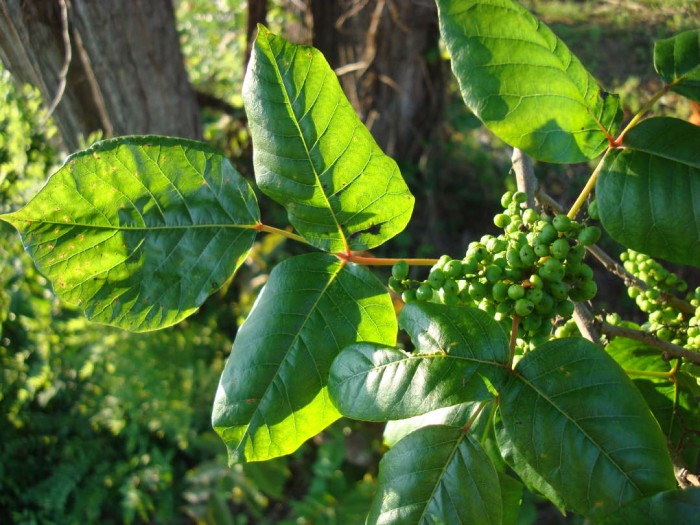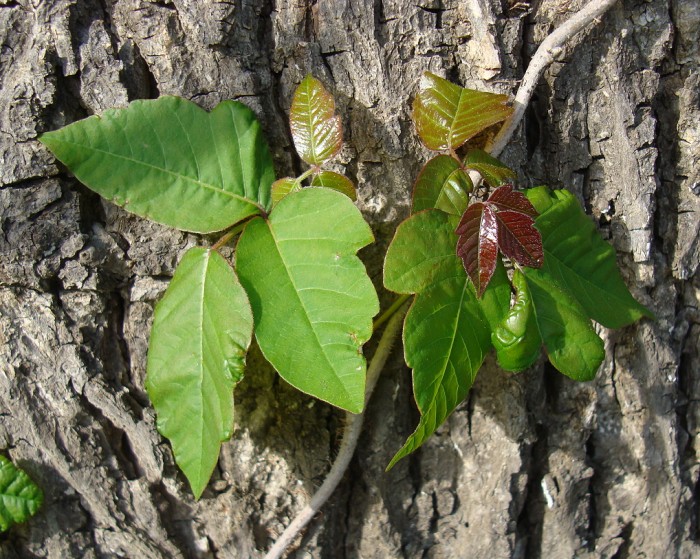A poison ivy primer
Ahhh, the sensations of summer…ocean sand between your toes, a cool drink in the shade, and red itchy welts courtesy of that three-leaved miscreant: poison ivy (Toxicodendron radicans). If you’ve had a run-in with poison ivy this summer or in summers past, here are a few interesting facts about this woody vine offered up by botanists Susan Pell, president of the Torrey Botanical Society, and Ken Wurdack, of the Botany Department at the Smithsonian’s National Museum of Natural History.
- Poison ivy belongs to the same plant family, Anacardiaceae, as mangos and cashews. All three of these plants produce urushiol, the compound that causes the itchy rash. People who chew the mango flesh from mango skins frequently get a blister rash on their lips. Pistachios also belong to this family but do not cause a rash. Poison oak and poison sumac are in the same genus as poison ivy.
- Every part of the poison ivy plant—leaves, stems, roots—is poisonous, so don’t burn it, Wurdack says. With burning, the urushiol becomes volatilized in the smoke and you can get it in your lungs, which is very dangerous and can even lead to death.
- Humans and possibly a few other primates are the only animals that get a rash from poison ivy. Your dog and cat don’t get it, nor do birds, deer, squirrels, snakes and insects. However, be sure to wash your dog after a walk near poison ivy because the urushiol can be carried on dogs’ fur and transferred to you!
- Scientists speculate urushiol evolved as an antimicrobial defense agent, says Susan Pell, protecting the poison ivy plant against infection….but not as a defense against people.
- In humans, contact with poison ivy causes a reaction known as a cell-mediated immune response. Basically, as Pell explains, the urushiol binds to proteins in the membrane of your skin cells and interferes with their ability to communicate with other cells. It tricks your immune system into regarding your own skin cells as foreign. “Urushisol is not an irritant burning your skin,” Pell adds. “The rash is actually a result of your own immune system attacking your own skin cells.”
- Ten to 15 percent of people are immune to poison ivy and will never have a rash. Repeated contact however will not give you immunity, in fact just the opposite, Pell explains. “The rashes get worse and worse as your immune system gets better and better at recognizing urushiol.”
- Poison ivy fruits, called drupes, are an important food for birds. Deer and insects eat the leaves. People think of it as a weed but in an ecological sense it is an early successional plant that is mostly found in disturbed areas.
- Over time, individual botanists have named some 30 to 40 different species of poison ivy across North America. A recent and comprehensive study, however, has reduced that number to one species, Toxicodendron radicans, with 5 sub-species –T. eximium, T. divaricatum, T. radicans, T. rydbergii and T. verrocosum. “Poison ivy has a lot of structural diversity: I’ve seen a free-standing poison ivy plant with three-inch leaflets growing right next to a climbing poison ivy plant with six-inch leaflets. They may look different, but they are the same species,” Pell adds. “Its morphological characteristics are very diverse and change in different habitats.” Its many different physical variations appear to be different species but are not.
- What triggers a poison ivy plant to climb is a mystery. Some poison ivy plants climb right away from seedlings and others do not. Individual populations of these plants often contain a mix of climbing and non-climbing plants.

The fruit of poison ivy, called drupes, are an important food source for birds. (Photo by Flickr user Zen Sutherland)
Posted: 18 August 2014
-
Categories:
Education, Access & Outreach , Feature Stories , Natural History Museum , Science and Nature




